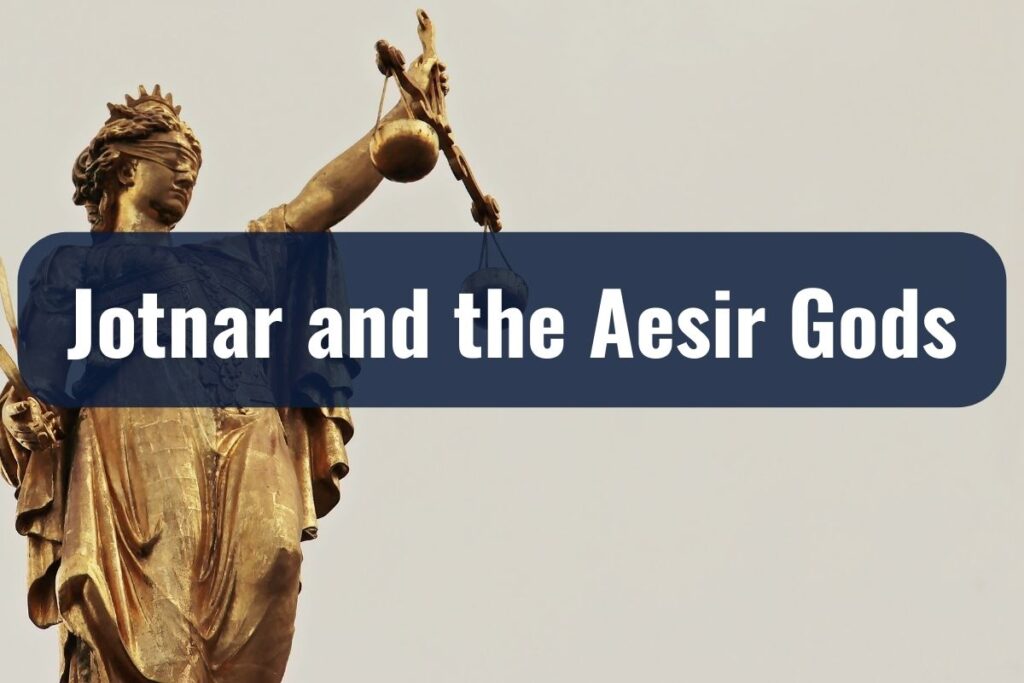Norse mythology, a vibrant and intricate system of beliefs and stories from the ancient Norse people, serves as a rich canvas depicting gods, goddesses, and a myriad of mythical creatures. This mythology, stemming from medieval Scandinavia, has captivated audiences for centuries, offering a window into the beliefs, values, and imaginations of the Vikings.
Central to these tales are the Jotnar (singular: Jotunn), often referred to as giants in English translations. These enigmatic beings, integral to Norse cosmology, are as fascinating as they are misunderstood. Unlike the simplistic portrayal of giants in modern media, the Jotnar of Norse mythology are complex, multifaceted beings, embodying both the benevolent and malevolent aspects of nature.
From their mythological origins to their pivotal roles in the sagas and their lasting impact on culture, we will delve deep into the lore of the Jotnar, exploring the myths and stories that have shaped their enduring legacy in Norse mythology.
Key Takeaways
- Jotnar are central figures in Norse mythology, symbolizing natural forces and chaos.
- Originating from Ymir, Jotnar are diverse, ranging from Frost to Fire Giants.
- They exhibit varied forms, from monstrous to beautiful, with unique powers.
- Jotnar are depicted in complex relationships with Norse gods, especially in stories of conflict and alliances.
- They play a significant role in Ragnarok, the Norse apocalypse.
- The Jotnar’s cultural impact extends into modern media, symbolizing life’s challenges.
Origins of the Jotnar of Norse Mythology
The Birth of the First Giant: Ymir’s Emergence
The saga of the Jotnar begins with the creation myth of Norse mythology, where the figure of Ymir stands tall as the progenitor of the giant race. According to the myths, in the yawning chasm known as Ginnungagap, where the icy realm of Niflheim and the fiery Muspelheim converged, Ymir, the primeval being, came into existence. From Ymir’s body, the first generation of Jotnar sprang forth, setting the stage for the complex tapestry of Norse cosmogony.
The Jotnar and the Cosmic Order
Ymir’s significance extends beyond his role as an ancestor. His enormous body, upon his demise at the hands of the gods, was used to fashion the world itself. Mountains were made from his bones, seas from his blood, and the sky from his skull. This act intertwines the Jotnar irrevocably with the very fabric of the cosmos, marking them as elemental forces in the Norse worldview.
The Evolving Realm of Jotnar
From Ymir’s descendants emerged a diverse and powerful race, inhabiting the realm known as Jotunheim. This land, one of the Nine Worlds in Norse cosmology, became the domain of the giants, characterized by rugged mountains, deep forests, and fortresses made of stone and ice. Jotunheim, lying on the borders of the world, was both a part of the Norse universe and a symbol of the unknown and untamed aspects of nature.
The Jotnar and Their Divine Counterparts
The relationship between the Jotnar and the Aesir (the principal pantheon of Norse gods) was complex and multifaceted. While often depicted as adversaries of the gods, the Jotnar were also their kin, through various marriages and alliances. This duality underscores the Jotnar’s role in Norse mythology as embodiments of both chaos and necessary counterbalances to the order represented by the Aesir.
Characteristics of the Jotnar

The Physicality and Powers of the Jotnar
The Jotnar, often depicted as giants, exhibited a wide range of physical forms in Norse myths. While many were indeed colossal in size, their appearances varied greatly, ranging from the monstrous and fearsome to the enchantingly beautiful. Some Jotnar possessed unique abilities, such as shape-shifting, control over elements, and formidable strength. These varied traits reflect the diverse nature of the Jotnar, mirroring the unpredictable and multifaceted aspects of the natural world they often symbolize.
Diversity Among the Jotnar: Frost Giants, Fire Giants, and More
The Jotnar were not a homogeneous group; they were as varied as the landscapes they represented. The most well-known among them are the Frost Giants of Jotunheim and the Fire Giants of Muspelheim. Frost Giants, like the infamous Jotunn Thrym, were often associated with ice, cold, and winter, symbolizing the harshness of the Scandinavian climate. Conversely, Fire Giants, such as the fearsome Surtr, embodied fire and destruction, often linked to volcanic activity and natural disasters.
Symbolism and Representation in Norse Myths
In Norse mythology, the Jotnar were more than mere adversaries of the gods; they represented essential natural forces. Their stories often revolve around themes of creation and destruction, growth and decay, reflecting the Norse understanding of the world as a dynamic and ever-changing place. The Jotnar, thus, were not just literal giants; they were personifications of mountains, storms, oceans, and other natural phenomena, embodying the awe and fear that these elements inspired in the ancient Norse.
Prominent Jotnar in Mythology
Jotunheim, the homeland of the Jotnar, stands as a testament to their might and mystery. Described as a rugged and untamed land, it contrasts sharply with the orderliness of Asgard, the realm of the gods. Jotunheim’s towering mountains, deep forests, and daunting fortresses are not just physical locations but also symbolize the untamed and chaotic aspects of nature that the Jotnar represent.
| Name | Type | Realm | Symbolism | Relationship with Gods |
| Loki | Trickster | Varied | Change, Deceit | Complex, often allied |
| Skadi | Huntress | Jotunheim | Winter, Mountains | Married to God Njord |
| Thrym | Frost Giant | Jotunheim | Strength, Hostility | Adversary of Thor |
| Surtr | Fire Giant | Muspelheim | Destruction, Fire | Enemy in Ragnarok |
Loki: The Trickster Giant
Loki, often considered a god, was in fact born a Jotunn and is one of the most complex and pivotal figures in Norse mythology. A master of deceit and shape-shifting, Loki’s role oscillates between that of a cunning ally and a troublesome foe to the gods. His lineage and actions link the world of the Aesir and the Jotnar, highlighting the interconnectedness and blurred lines within Norse cosmology.
Skadi: The Huntress of the Mountains
Skadi, a giantess known for her prowess in hunting and skiing, is another notable figure among the Jotnar. Her marriage to the god Njord, as part of a peace agreement between the gods and giants, symbolizes the nuanced relationships between these two groups. Skadi’s character embodies the harshness of winter and the mountains, as well as the respect and awe these elements commanded.
Thrym: The Frost Giant King
Thrym, the king of the Frost Giants, is central to one of the most entertaining tales in Norse mythology. His theft of Thor’s hammer, Mjolnir, and the subsequent comedic events that ensue to retrieve it, highlight the ongoing rivalry and interaction between the giants and the gods. Thrym’s story is a blend of humor and cunning, providing a different perspective on the nature of the Jotnar.
Jotnar and the Aesir Gods

A Tapestry of Rivalry and Alliance
The relationship between the Jotnar and the Aesir, the principal pantheon of Norse gods, is a tapestry woven with threads of conflict, alliance, enmity, and kinship. This dynamic interplay reflects the nuanced nature of the Jotnar, who are not merely adversaries of the gods but also their relatives, allies, and sometimes even spouses.
Hostility and Battles: The Eternal Struggle
The conflicts between the Jotnar and the Aesir are central to many Norse myths, symbolizing the eternal struggle between order and chaos. Battles with giants feature prominently in the sagas, with gods like Thor and Odin often engaging in epic combats against formidable Jotnar. These conflicts are not just physical battles but are also representative of the struggle against the untamed forces of nature.
Alliances and Marriages: The Bonds that Bind
Despite their conflicts, the Aesir and Jotnar are closely interconnected through various alliances and marriages. These unions often serve as diplomatic solutions to conflicts or strategic moves to maintain balance in the cosmos. For instance, the marriage between the Aesir god Njord and the Jotunn Skadi, and the complex relationship between Loki and the gods, underscore the deep connections that transcend simple categorization of friend or foe.
The Role of Loki: A Bridge Between Worlds
Loki, a figure of immense complexity, embodies the fluidity of the relationship between the Jotnar and the Aesir. As a Jotunn who resides among the gods, his actions often blur the lines between the two groups, creating scenarios that are as chaotic as they are transformative. His role as a trickster and a catalyst for change is pivotal in many myths, reflecting the unpredictable nature of the relationships within the Norse pantheon.
Cultural Impact and Legacy
The Jotnar in Modern Media and Literature
The legacy of the Jotnar extends far beyond the ancient texts of Norse mythology. In contemporary times, these mythical giants have found a new life in modern media and literature. From fantasy novels to movies, television series, and video games, the Jotnar have been reimagined and reintroduced to new generations, often as formidable and enigmatic characters. These adaptations, while sometimes straying from the original myths, continue to fuel the fascination with these ancient beings and their complex narratives.
Symbolism and Interpretation in Contemporary Culture
The Jotnar, with their multifaceted nature, have become symbols for various concepts in modern culture. They often represent the untamed forces of nature, the unknown, and the aspects of life that are beyond human control. In a broader sense, they are seen as metaphors for challenges and obstacles, embodying the human struggle against overwhelming odds. This symbolic representation resonates in different forms of artistic expression, from literature to visual arts, where Jotnar’s imagery and characteristics are used to convey deeper meanings and themes.
The Enduring Appeal of Norse Mythology
The continued interest in Norse mythology, with the Jotnar as key figures, is a testament to the enduring appeal of these ancient stories. They provide a rich source of inspiration and fascination, reflecting timeless human themes such as heroism, conflict, and the relationship with the natural world. The Jotnar, in particular, with their complex and contradictory nature, continues to captivate the imagination, serving as a bridge between the ancient world and modern interpretations.


